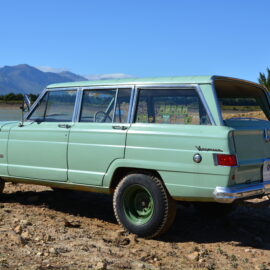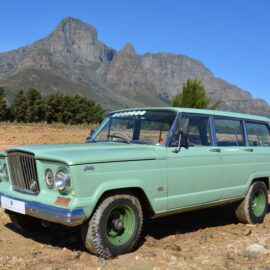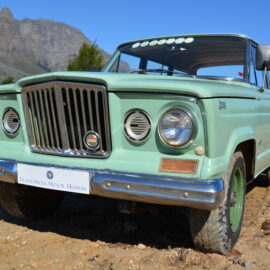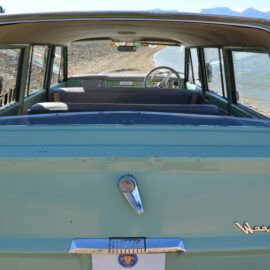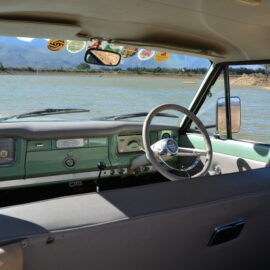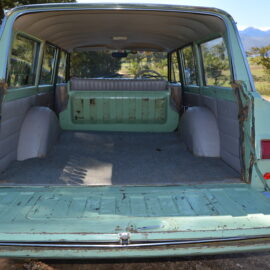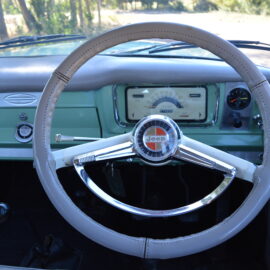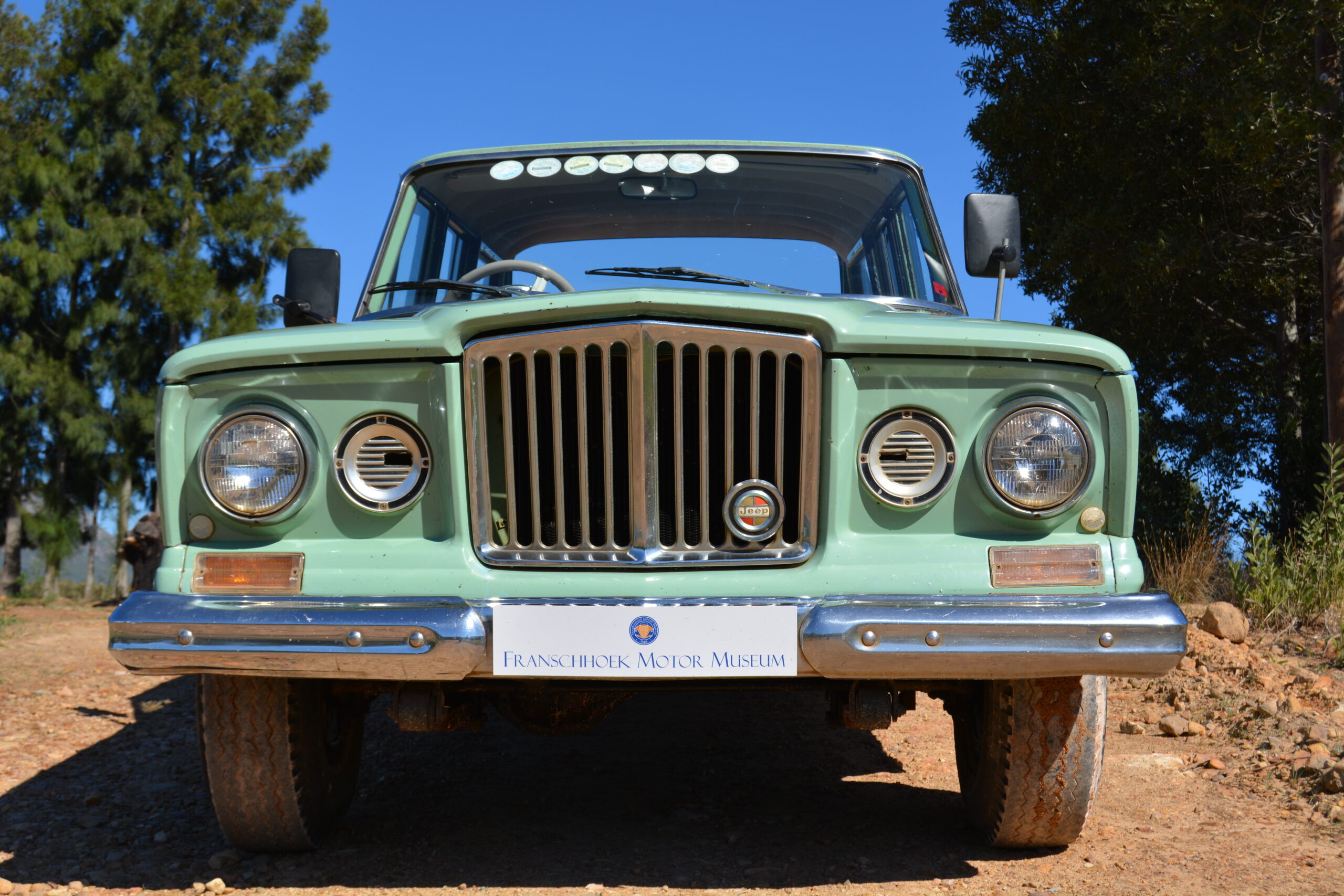
30 Mar Collection In Action: Jeep Wagoneer
SUVs are one of South Africa’s highest-selling modes of transport with applications ranging from dinky two-wheel drive soft-roaders to full-sized four-wheel drive machines bristling with dual range transmissions and diff-locks that are capable of conquering the world. Mike Monk looks at the first of the breed…
The origins of four-wheel drive ‘all-terrain vehicles’ began in 1945 when Willys-Overland produced a civilian version of its Jeep, the CJ, which had first appeared in 1941 as a military vehicle, coded MB. The CJ then led to the development of the Land Rover, which made its public début at the 1948 Amsterdam Motor Show. But these utilitarian vehicles were hardly family or urban friendly in their appearance and operation. The first vehicles that came close to meeting these criteria were the International Harvester Scout 80, which arrived in 1961 but was rather crude in its make-up – essentially a pick-up with a hardtop, a trend used by Ford with its Bronco released in 1966. But in between these two, Kaiser-Jeep – otherwise known as Willys Motors – had introduced the Wagoneer SJ in 1963 as a four-wheel drive station wagon designed to take advantage of America’s growing interest in off-road capable vehicles, essentially making it the first pukka SUV by today’s definition. The Range Rover, which is credited with kick-starting the escalating global sales success of SUVs, only saw the light of day in 1970.
Built in Jeep’s Toledo, Ohio assembly plant, the Wagoneer was not exactly brimming with technology – it was basic, but at least boasted a purpose-built bodyshell. And it is perhaps something of a surprise to learn that production of the Wagoneer started in this country only a short while after it began manufacture in the USA. Local models began rolling off the Willys-Afrika assembly lines in Bramley, Johannesburg in January 1965 following a R4-million investment in establishing a modern plant – including Martin spot-welders – by the parent company. With more than 40 per cent local content, build quality was claimed to be superior to that ruling in America. It sold for R3 390.
The Wagoneer featured here was donated to the Franschhoek Motor Museum by Mooiplaats resident Joh Groenewald and is one of the first to have been assembled in SA. Purchased new in 1965, it is still in its original light-green paint and is fitted with a Tornado 230,5 ci (3,78-litre) straight-six, America’s first post-WW2 mass-produced overhead-cam engine. The all-iron motor was offered in two states of tune: with an 8,5:1 compression ratio it delivered 104 kW at 4 000 r/min and 285 N.m of torque at 1 750 (as fitted to FMM’s example), while the 7,5:1 cr version’s peak outputs dropped to 99 kW at 4 000 and 270 N.m at 2 400, respectively. Running on standard 7.10×15-inch tyres and with a 4,09:1 final drive ratio, a period road test achieved a 0-60 mph (96 km/h) time of 18,2 seconds, a standing-start quarter-mile time of 20,4 seconds and a top speed of just over 140 km/h. Steady speed fuel consumption ranged from 12,4 ℓ/100km at 48 km/h to 17,3 ℓ/100km at 96 km/h.
A three-speed gearbox was standard with (probably due to the conversion to right-hand drive) the column shift unusually mounted to the right of the steering column. The Wagoneer’s all-wheel drive capability was not permanent: a four-position floor-mounted transfer lever selecting rear-wheel drive, neutral, four-wheel drive and low range (2,03:1), with warning lights for neutral and 4wd engagement (which could be done on the move). Front hubs need to be manually locked for 4wd use. Neutral offered power take-off options; such was the vehicle’s versatility. The combination of leaf-sprung live axles front and rear and a big, lofty, heavy body offers a reasonable if somewhat lively ride over most terrains – ground clearance is 197 mm – but handling quickly goes from under- to oversteer during heavy cornering. The unassisted steering has 5,5 turns from lock to lock and the turning circle is 13,5 metres.
Hydraulic drum brakes have a hard task retarding the Wagoneer, which tips the scales at around 1,8 tons. Prone to fade, the brakes need sensitive treatment under hard going. The parking brake, which operates on the prop shaft, is foot-operated by a pedal awkwardly located to the right of the accelerator. Release is via an under-dash lever.
While not exactly luxurious, the Wagoneer has bench seats front and rear, a padded facia, good instrumentation with variable lighting, door-activated courtesy lights, windscreen washers and hard-pile carpeting. Overall sound proofing was said to be “of the highest order” but wind and road noise intrude as speed rises. Luggage space is given as 1,4 m3 and utility space an apartment-sized 2,8 m3! From 1964, air conditioning and seatbelts were optional, and later a brake booster was also offered as an extra. These were all standard on the Super Wagoneer introduced for the 1966 model year, together with power steering with a tilting wheel, electric tailgate operation, tinted glass and some other cosmetic features. The ’66 Wagoneer changes included a couple of minor styling tweaks but most noticeably a new full-width grille, improved instrumentation, more comfortable seats, and a floor-mounted gear shift.
In 1967 the Tornado motor was replaced by a 232 ci (3,8-litre) overhead-valve Hi-Torque Six that produced 108 kW)at 4 300 r/min and 291 N.m at 1 600. Final drive stayed the same but wheel size was increased to 16-inches, which adversely affected performance, 0-96 km/h now taking 19,7 seconds, the quarter-mile 20,8 seconds and top speed dropping to just over 136 km/h. But steady speed fuel economy improved to 10,3 ℓ/100km at 48 km/h and 16,1 ℓ/100km at 96 km/h. Soon after, a 5,4-litre V8 was offered, delivering 186 kW. A 200 kW version mated with an automatic transmission was fitted to the Super Wagoneer model.
FMM’s Wagoneer is a weathered example – ‘patina on wheels’. The remnants of stickers on the nearside rear glass indicate that Joh and his family went here, there and everywhere – especially to game parks – in the Jeep, and it is easy to imagine their adventurous spirit, sitting high-up and master of all they surveyed thanks to the generous glasshouse and slim pillars. Mind you, it must have been tiring travelling along because the ride is hardly cosseting and the steering is both slightly heavy and requiring arm-straining control of the big, leather-sheathed two-spoke wheel. Keeping the Wagoneer in a straight line demands constant correction – rutted off-road tracks are particularly demanding but the trick is not to fight it: slightly wider wheels than original are fitted.
Minimalist instrumentation comprises a speedo, fuel and temp gauges and warning lights for oil, amps and indicators – a rev-counter was added later. The gearshift is a floor-mounted Fulray conversion and the ratios are such that the Tornado, while not raising a storm, pulls strong in any gear. Driving around some hilly farmland I could not help but feel that the Jeep would pretty much trample its way over almost any terrain placed in its path.
The Wagoneer is cavernous inside as the volume figures suggest, the rear bench folds flat and the horizontally split tailgate’s window can be wound down for added convenience – and provide through-flow ventilation in the absence of any air-con! Fifty years ago the Jeep offered South Africans the opportunity to emulate the voortrekkers and explore ons land with confidence – it was simple, rugged, reliable and full of character. A whole new world of adventure motoring was opened up.
After the American Motor Corporation (AMC) took over the ailing Kaiser-Jeep in 1970, the still-used (but much modified) Quadra-Trac 2wd-4wd system was developed but from then on as the model range became more and more outdated. A series of different engines – including 5,9- and 6,6-litre V8s – and derivatives were introduced, but by 1991, some 28 years after launch, the sturdy SJ was at an end. But it had sewn the seed of what today is a global marketing success story.
Visitor Note: The Jeep Wagoneer is currently on view in Hall C.
(This story is based on my article that first appeared in the Jun/Jul 2014 issue of Classic & Performance Car Africa magazine.)




